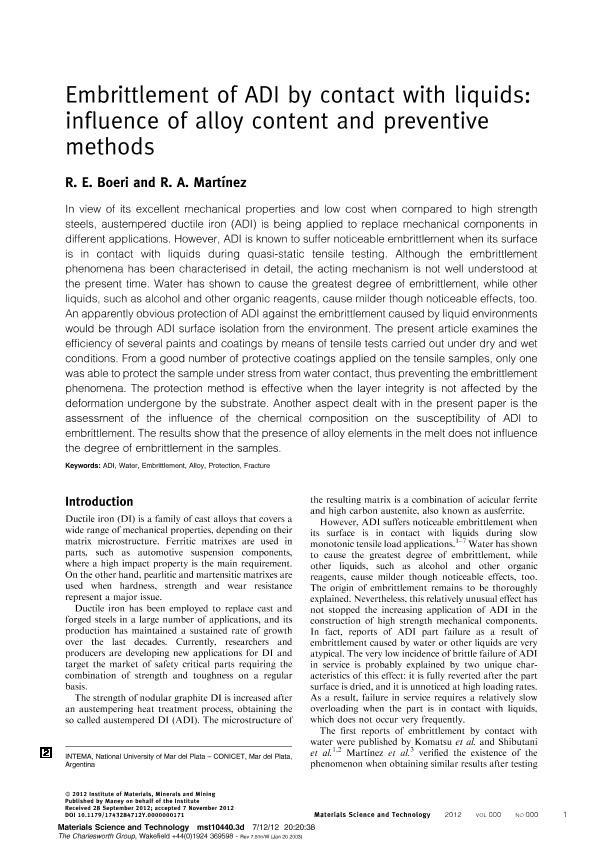Mostrar el registro sencillo del ítem
dc.contributor.author
Boeri, Roberto Enrique

dc.contributor.author
Martinez, Ricardo Antonio

dc.date.available
2015-11-12T17:23:12Z
dc.date.issued
2013-06
dc.identifier.citation
Boeri, Roberto Enrique; Martinez, Ricardo Antonio; Embrittlement of ADI by contact with liquids: Influence of alloy content and preventive methods; Maney Publishing; Materials Science and Technology; 29; 6; 6-2013; 665-671
dc.identifier.issn
0267-0836
dc.identifier.uri
http://hdl.handle.net/11336/2751
dc.description.abstract
In view of its excellent mechanical properties and low cost when compared to high strength steels, austempered ductile iron (ADI) is being applied to replace mechanical components in different applications. However ADI is known to suffer noticeable embrittlement when its surface is in contact with liquids during quasi static tensile testing. Although the embrittlement phenomena has been characterized in detail, the acting mechnism is not well understood at the present time. Water has shown to cause the greatest degree of embrittlement, while other liquids, such as alcohol and other organic reagents, cause milder though noticeable effects too. An apparently obvious protection of ADI against the embrittlement caused by liquid environments would be through ADI surface isolation from the environment. This article examines the efficiency of several paints and coatings by means of tensile tests carried out under dry and wet conditions. From a good number of protective coatings applied on the tensile samples, only one was able to protect the sample under stress from water contact, thus preventing the embrittlement phenomena. The protection method is effective when the layer integrity is not affected by the deformation undergone by the substrate. Another aspect dealt with in this paper is the assesment of the influence of the chemical composition on the susceptibility of ADI to embrittlement. The resuls show that the presence of alloy elements in the melt does not influence the degree of embrittlement the samples.
dc.format
application/pdf
dc.language.iso
eng
dc.publisher
Maney Publishing

dc.rights
info:eu-repo/semantics/openAccess
dc.rights.uri
https://creativecommons.org/licenses/by-nc-sa/2.5/ar/
dc.subject
ADI
dc.subject
ALLOY
dc.subject
EMBRITTLEMENT
dc.subject
FRACTURE
dc.subject
PROTECTION
dc.subject
WATER
dc.subject.classification
Ingeniería de los Materiales

dc.subject.classification
Ingeniería de los Materiales

dc.subject.classification
INGENIERÍAS Y TECNOLOGÍAS

dc.subject.classification
Físico-Química, Ciencia de los Polímeros, Electroquímica

dc.subject.classification
Ciencias Químicas

dc.subject.classification
CIENCIAS NATURALES Y EXACTAS

dc.title
Embrittlement of ADI by contact with liquids: Influence of alloy content and preventive methods
dc.type
info:eu-repo/semantics/article
dc.type
info:ar-repo/semantics/artículo
dc.type
info:eu-repo/semantics/publishedVersion
dc.date.updated
2016-03-30 10:35:44.97925-03
dc.journal.volume
29
dc.journal.number
6
dc.journal.pagination
665-671
dc.journal.pais
Reino Unido

dc.journal.ciudad
London
dc.description.fil
Fil: Boeri, Roberto Enrique. Consejo Nacional de Investigaciones Científicas y Técnicas. Centro Científico Tecnológico Mar del Plata. Instituto de Investigación en Ciencia y Tecnología de Materiales (i); Argentina. Universidad Nacional de Mar del Plata. Facultad de Ingenieria; Argentina
dc.description.fil
Fil: Martinez, Ricardo Antonio. Consejo Nacional de Investigaciones Científicas y Técnicas. Centro Científico Tecnológico Mar del Plata. Instituto de Investigación en Ciencia y Tecnología de Materiales (i); Argentina. Universidad Nacional de Mar del Plata. Facultad de Ingenieria; Argentina
dc.journal.title
Materials Science and Technology

dc.relation.alternativeid
info:eu-repo/semantics/altIdentifier/url/http://www.maneyonline.com/doi/abs/10.1179/1743284712Y.0000000171?journalCode=mst
dc.relation.alternativeid
info:eu-repo/semantics/altIdentifier/doi/http://dx.doi.org/10.1179/1743284712Y.0000000171
Archivos asociados
